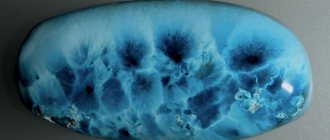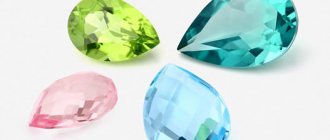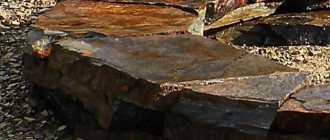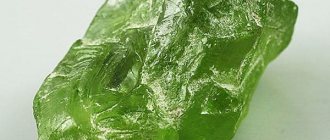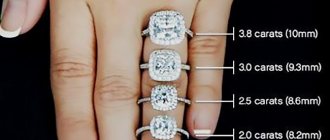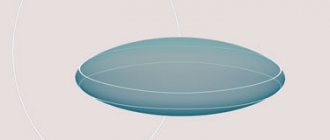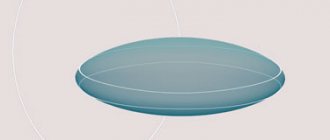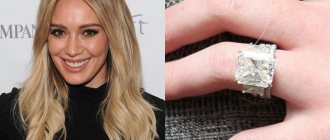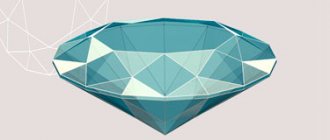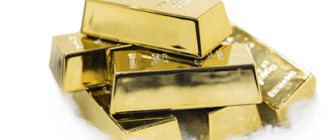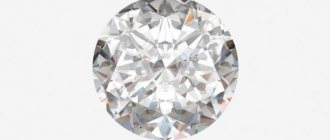Cabochon is a decorative a stone that has no edges. During processing, its surface becomes smooth and convex. Both the insert and the type of cut are designated by the term cabochon. Cabochon is translated from French as “carnation with a head.” But the jewelry name probably comes from the word caboche, meaning head.
A smooth cut is simpler than a faceted cut. People mastered it first. Most ancient peoples have relics in the form of cabochons. But it was the French who took the art of polishing to a new level and coined a term for it that is still used today.
Varieties of cabochon shapes
Stone cutters use several methods of finishing crystals, resulting in the following types of cabochons:
| Cabochon type | Base shape | Top shape |
| Low convex | flat | low-convex |
| Concave | distinctly concave | |
| Double | convex (slightly less) | convex (slightly larger) |
| Single | flat | distinctly convex |
After cutting, specimens of different shapes appear from the hands of professionals:
- rounded;
- oval.
Jewelers were able to create these standard forms many centuries ago. And modern craftsmen have mastered new technologies and cut out the following cabochons:
- in the form of a drop;
- rectangular;
- square;
- triangular;
- in the shape of a stylized heart;
- in the shape of an Orthodox cross;
- polygonal.
When choosing a form for processing, a professional must take into account the characteristics of the crystal. If it has an optical effect (asterism), then it is better to cut the cabochon in the shape of a circle.
And if the mineral is thin at the edges, then it is oval.
The purpose of the future accessory is also taken into account. If you plan to create a men's ring, the stone is traditionally given a cubic shape. And any variety is suitable for women’s jewelry.
Usage history
The term cabochon itself appeared around the 17th century in France. Some translators claim that the word is translated into Russian as the phrase “carnation with a hat.” And another group of philologists believes that the literal translation is “head”.
But long before the term appeared, people knew what a cabochon was.
Helpful information
This technique was used in the processing of precious and semi-precious stones in Ancient Egypt and India. However, this cut gained popularity thanks to a French statesman named Jules Mazarin.
The jewelers who worked on the stones from his collection began to use a special technique for processing crystals. It made it possible to minimize losses. After all, the craftsmen did not cut edges from natural stones, but only polished them, creating rounded specimens. Rich people liked the cabochon cut so much that they gladly began to buy jewelry with such inserts. The fashion for jewelry spread throughout Europe and was relevant until the beginning of the 20th century. At this time, technologies emerged that allowed jewelers to give precious and semi-precious stones many facets. Simply polished samples were considered ugly. Only at the end of the last century did masters remember what a cabochon was and began to widely use this technique. She remains in demand to this day. Fashionistas of all ages enjoy wearing jewelry with traditional round and oval crystals.
Cardinal Collection
Cabochon cutting initially meant only polishing the mineral. The first cabochons made from natural stones were different from modern ones. The craftsmen did not give them a specific shape, but simply smoothed out the irregularities and corners.
Then jewelers began to process stones in the form of a circle and an oval. Therefore, this form received the French name “caboche”. Translated - “head”.
According to one version, the cabochon form became widespread in Europe thanks to the French cardinal Giulio Mazarin (in French - Jules Mazarin), a church and political figure of the mid-17th century. He was famous for his collection of 18 large diamonds.
The Cardinal constantly admired the jewelry and decided to further emphasize their beauty and transparency. At his request, the jewelers processed the diamonds and gave them an oval shape.
According to another version, they learned about what a cabochon is in France before the birth of Mazarin - in the 16th century. Round stones were brought from the Indians.
However, at that time the form did not find fans. The cabochon became popular only thanks to Mazarin's love for diamonds.
Methods of application
Modern craftsmen use cabochons in such cases.
- Precious and semi-precious minerals are set into precious metals. Gems become inserts into earrings, brooches, pendants, men's rings, and women's rings. Recently, wide men's and women's cabochon bracelets have come into fashion.
- Ornamental stones are used to decorate wallets and women's handbags.
- Jewelry glass has become indispensable in the manufacture of costume jewelry.
Cabochons can be seen in both expensive jewelry and cheap accessories.
Properties
In order for the cabochon to acquire the best aesthetic properties and the greatest decorative value, gems with:
- unusual design;
- optical effects (asterism or iridescence);
- bright color;
- original divorces;
- multi-colored veins on the surface.
When cutting cabochons, ordinary consumers and jewelers appreciate the fact that the resulting stones are not similar to each other, with completely different patterns and shades.
What stones are suitable for cutting?
Star Ruby
Through experience over many centuries, it has been determined which stones reveal their best qualities in cabochons.
Among the precious minerals, the most famous names can be listed:
- Star ruby is a cabochon with an asterism effect. It has the property of transforming light into a radiant star.
- A star sapphire is a blue colored gemstone that has inclusions that become a star when cut.
Among the semi-precious ones:
- selenite - translucent feldspar, bluish-milky hue, with moonlight;
- cat's eye - yellow-green chrysoberyl, with a low degree of transparency, inside it there is a stripe of concentrated color, reminiscent of a cat's eye;
- turquoise is an opaque gem of a slightly green-blue color, covered with a mesh;
- opal is a stone with a structure due to which light is refracted inside and decomposed into many colors and shades;
- jade is a matte gemstone that has a wide variety of shades and a delicate shine;
- agate is a stone consisting of many layers of different shades, which make it possible to obtain a characteristic pattern on the surface;
- malachite is a dark green rock with a particularly exquisite pattern.
Cabochon production
In past centuries, this cut was used to process the most expensive precious crystals - rubies, emeralds, sapphires, even diamonds. Jewelers used primitive tools - a special grinding wheel. The upper surface of the gem was ground and polished, while the lower surface was left in its original form. Afterwards, the ennobled crystal was inserted into a frame made of gold or silver. A more complex cutting technique appeared only towards the end of the 14th century.
Russian craftsmen used the cabochon processing technique before Peter I ascended the throne. During his reign, precious and semi-precious stones began to be processed in other ways. Only a few centuries later, cabochons came back into fashion.
Over many centuries, production technology has not changed very much.
Nowadays, jewelers do not perform actions with their hands, but use special electronic devices. The whole process obeys a certain algorithm:
- The mineral is cut into small pieces if necessary.
- The workpieces are degreased.
- Contours are applied to them using stencils.
- Excess is removed using a file or disk along the outlined contours.
- The sharp corners of the workpiece are ground on a grinding wheel.
- The upper side is made dome-shaped.
- The surfaces are ground and the top is also polished.
In the 21st century, famous designers very often use natural and artificial cabochon-cut crystals in their collections. After this treatment, the internal glow of the crystals and optical effects are revealed to the maximum.
Manufacturing instructions
We give the mineral its shape
In the 21st century, the principles of making cabochons have remained the same. But production technology has changed.
Previously, all stages of the wizard were performed manually. Today everything is done on professional machines.
First, jewelers prepare pieces of 4-8 mm in size from stone plates. Then the sample sawn into blanks is degreased.
The next stage is drawing the contours using a stencil.
Then the pebble is cut along the contour using a saw or disk. There are sharp corners that can cause you to cut yourself. The master removes them with nippers or a grinding disc.
We carry out grinding
Now the stone needs to be polished. After this treatment, the corners become smooth. And the stone itself takes on the necessary shape.
The workpiece is glued to a special stand to make it more convenient to continue processing. After this, the master marks chamfers on the mineral. If they are not done, chips on the surface of the stone are possible when secured in a tight frame.
After this, the stone is ground again on a drum, belt or disc grinder.
The jeweler selects the material depending on the strength of the stone being processed. The sanding disc has soft abrasives. The grinding speed depends on the location of the stone. The closer to the center, the faster the disk rotates.
In drum sanders, the abrasive is located over the entire surface of the disc.
Universal tape tool. It allows grinding with hard and soft impact on the stone.
Be sure to treat the bottom of the stone. If the surface is wavy, the stone may fall out of the frame.
Final stage
The next step in creating a cabochon is polishing. Jewelers polish the mineral by hand using pieces of leather and felt.
A diamond-coated grinding wheel is also used. Optimal grain size is 5 microns.
Jewelers rarely polish the lower part of the stone unless it will be visible in the jewelry.
Can it be done at home?
It is difficult for a non-professional to process natural stone and give it a rounded shape. Special expensive equipment will be required. A knife and one sanding disc will not work.
You need to know how to process stones and understand their physical properties.
Making a cabochon is a task that is best left to jewelers.
Secrets hidden in cabochons
In past centuries, the secrets of cabochon processing were passed on from older generations to younger ones. Nowadays they are generally known, every master can use them in his work.
- Almost any mineral can be refined in this way. But opaque and translucent samples look most impressive.
- Even relatively soft specimens (with a Mohs hardness level below 7) can be sanded perfectly.
- Optical effects (star sapphire, cat's eye) are best visible only on a convex surface.
- Sometimes cabochons are cut in a special way - the so-called “carbuncle”. The base of such a crystal is not left flat, but made concave. The result is two domes located one above the other. This is how dark transparent gems are processed.
- There is a finish that combines cabochon (top surface) and faceted crystal (bottom). The front side is given a dome shape. On the back - edges are applied.
- Large cabochons made of soft or thin crystal are reinforced with durable artificial or natural material. Most often, American jewelers do this.
- Processing in the form of a triplet (doublet) allows you to refine specimens of insufficient strength and small thickness. This method also enhances the color effects.
Knowing these rules and applying them in practice, you can create a beautiful gem.
Peculiarities
Cabochon is a treatment that allows you to reveal the depth of color of the gemstone. It makes it possible to carefully examine the pattern inside the mineral, to see traces of its formation and inclusion of other elements. In this case, the optical effects will be less noticeable than with faceted cutting.
The cabochon is formed as follows. The bottom of the stone is ground to make it flat. The upper one is turned into a semicircle with the most regular shape. If necessary, the stone is subjected to further processing - to lighten, increase contrast, and color saturation. There are also “double cabochons”, consisting of two semicircles: they create an unusual glow effect.
The method is used for processing opaque and translucent stones with a dull shine. Transparent minerals are rarely processed into cabochons: for them, the play of light that appears during faceted cutting is more valuable.
Cabochons in jewelry
Nowadays, when new materials are used everywhere, cabochon cutting is used in the processing of jewelry glass and polymer clay. Such inexpensive specimens are used to decorate teenage and youth items:
- Clutches. This fashionable addition to an evening look will emphasize the miniature details and elegance of the lady. Thanks to the clutch, your hand will look more elegant, and it will also be easier to keep track of a small handbag and protect yourself from being attacked by a thief.
- Bags. A tote bag will also fit perfectly into any look. The main thing is to match the stones with the colors of the outfit. Also an interesting idea would be a roll call of cabochons on the bag and in jewelry on the girl’s neck, ears or wrist.
- Wallets. Decorated with precious stones, they will look elegant and attractive. Such luxury will remind you of the past - of expensive handbags and handbags made of silk or satin. Moreover, it is believed that the more expensive the wallet, the more money it will save.
- Necklace. Jewelry made from cabochons will emphasize the status of a lady. It will also highlight a thin neck and shoulders and complement a plain outfit. If the stones are located vertically, they will visually make the neck thinner.
- Brooches. An unusual brooch will complement a simple or plain outfit and add individuality to a lady’s image. In the jewelry market you can find a variety of decorations in the shapes of insects, animals, flowers and much more.
- Belts. Due to the fact that the belt is decorated with precious stones, it is not embarrassing to wear it to a special event or a party. It will emphasize the silhouette and make the waist visually thinner. Moreover, such a detail of the outfit will make the girl unique and add a touch of elegance to her appearance.
Buying a finished product with cabochons will cost more than a self-made item. In order to firmly fix the stone, you need to buy special bases. To beautifully decorate minerals, bead or pearl braiding is used.
Cabochons with images of animals, portraits or plants will look especially beautiful. The stone can be decorated with a silk ribbon or made into an amulet. Such a homemade piece of jewelry will make the lady’s image unique, since such stones are an original idea of the author.
Before choosing an addition to your outfit, you need to match the colors. The cabochon must fit correctly into the image, otherwise it will look bad.
- When purchasing a stone for an evening outfit, you should give preference to bright and rich options. They will attract the attention of others, and will also look advantageous against a dark background.
- Small stones made in pastel colors. They will not stand out, but will become an important addition to the image.
- An oval cabochon is preferable for women over 45 years old.
- Girls are recommended to choose unusual cuts: heart-shaped or more interesting shapes.
- Men should take a closer look at stones with clear edges: triangles, squares, rhombuses, crosses.
Only by fully understanding what a cabochon is can you make a choice in favor of this cut. Thanks to information from history, it becomes clear where modern trends come from. And thanks to ideas about the various uses of cabochons in jewelry, you can understand which option suits a person best.
Rating of the most expensive rubies
Ruby is a gemstone of the highest category. The investment value of red corundums, especially those that fit the definition of “pigeon blood”, is very high. At world-famous auctions, high-quality crystals are sold for much more than the original price. Moreover, the cost per unit mass of precious stones is constantly growing.
The top five most expensive in the world is opened by the unrefined Burmese stone Spectacular Ruby and Diamond Ring in the color of “pigeon’s blood”. Its price is 11 million US dollars. Advantages noted by experts: impressive size and weight, dense color, ancient cut shape.
In 4th place is a Mogok crystal of the same coveted color - An Exceptional Ruby and Diamond Ring. One of the purest red corundums is worth 13 million US dollars.
The 3rd place is occupied by The Jubilee Ruby stone - $14.1 million. The extraordinary purity, brightness of color, and lack of thermal effects allowed gemologists to characterize the gem as an “exceptional treasure.” Microscopic inclusions prove Burmese origin.
In 2nd place is the raw red corundum The Crimson Flame with US$18.3 million. It is also described by specialists as an “exceptional treasure”.
The most expensive ruby in the world today is The Sunrise. It weighs 25.59 carats and was sold in 2015 for US$30.3 million. A stunning Burmese pigeon's blood stone with distinct internal color highlights. Untreated, exceptionally transparent and bright. Just admire him in this video.
If you rank based on price per carat, the list will be different.
- Patino ruby weighing 32.08 ct. cost the buyer $209,998 per carat.
- Ring with a Mogok gem weighing 29.62 ct. sold for $249,154.
- Burmese ruby weighing 10.1 carats. the diamond brooch is valued at $834,468.
- Graff weighs 8.62 ct. in a diamond ring sold for almost a million per unit - $997,727.
- Illustrious Sunrise. They paid $1,185,451 per carat.
